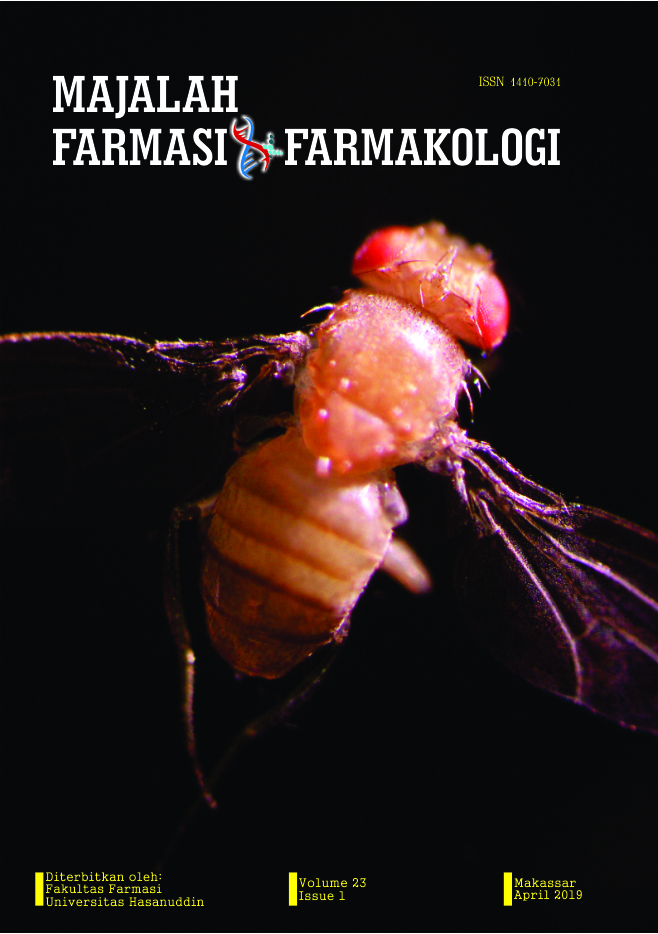PENGARUH BAHAN TAMBAHAN MALTODEXTRIN DAN GOM ARAB TERHADAP KADAR TOTAL POLIFENOL DARI EKSTRAK TEH HIJAU (Camellia sinensis) SETELAH PENYIMPANAN
Abstract
Teh hijau (Camellia sinensis) mengandung senyawa polifenol utamanya epigallocatechin-3-gallate (EGCG), epigallatocatechin (EGC), epicatechin-3-gallate (ECG), dan epicatechin (EC) yang dapat berfungsi sebagai antioksidan. Senyawa polifenol tidak stabil pada temperatur, pH dan oksigen, sehingga ditambahkan bahan enkapsulasi maltodextrin dan gom arab untuk mempertahankan kadar polifenol selama masa penyimpanan. Penelitian ini bertujuan untuk mengetahui perbandingan bahan maltodextrin dan gom arab sebagai pengenkapsulasi dalam mempertahankan kadar polifenol dari ekstrak teh hijau selama masa penyimpanan. Ekstraksi dilakukan secara remaserasi menggunakan pelarut etanol 70 % dengan perbandingan 1:5. Enkapsulasi ekstrak teh hijau menggunakan maltodextrin dan gom arab, perbandingan ekstrak teh hijau dengan enkapsulasi yaitu 1:5, 1:1 dan 1:2. Pengujian kadar total polifenol menggunakan metode spektrofotometri UV-Vis dengan larutan standar asam galat. Hasil penelitian menunjukkan bahwa enkapsulasi ekstrak teh hijau dapat mempengaruhi kadar total polifenol.
References
Bhagwat, S., Beecher, G. R., Haytowitz, D. B., Holden, J. M., Dwyer, J., Peterson, J., ... & Balentine, D. A. 2003. Flavonoid composition of tea: Comparison of black and green teas. Agricultural Research Service. USDA database for the flavonoid content of selected foods.
Jigisha A, Nishant R, Navin K, Pankaj G. Green tea: a magical herb with miraculous outcomes. Int. Res. J. Pharm. 2012; 3:139–48.
Si W, Gong J, Tsao R, Kalab M, Yang R, Yin Y. Bioassay-guided purification and identification of antimicrobial components in Chinese green tea extract. J Chromatogr A. 2006;1125:204e210.
Kusmiyati, M., Sudaryat, Y., Lutfiah, I.A., Rustamsyah, A.,& Rohdiana, D. 2015. Aktivitas antioksidan, kadar fenol total dan flavonoid total dalam teh hiaju (camellia sinensis(L)O. Kuntze) asal tiga perkebunan Jawa Barat. Jurnal Penelitian Teh dan Kina, 18(2),101-106.
Ishii, T., Mori, T., Tanaka, T., Mizuno, D., Yamaji, R., Kumazawa, S., ... & Akagawa, M. 2008. Covalent modification of proteins by green tea polyphenol (–)-epigallocatechin-3-gallate through autoxidation. Free Radical Biology and Medicine, 45(10), 1384-1394.
Chung, F-L. 2002. Tea and cancer prevention: Studies in animals and humans. Third International Scientific Synposiumbon Tea and Human Health: Role of Flavonoids in the Diet, Sept. 23,.
Steinmann, J., Buer, J., Pietschmann, T., & Steinmann, E. 2013. Anti‐infective properties of epigallocatechin‐3‐gallate (EGCG), a component of green tea. British journal of pharmacology, 168(5), 1059-1073.
Sang, S., Yang, I., Buckley, B., Ho, C. T., & Yang, C. S. 2007. Autoxidative quinone formation in vitro and metabolite formation in vivo from tea polyphenol (-)-epigallocatechin-3-gallate: studied by real-time mass spectrometry combined with tandem mass ion mapping. Free Radical Biology and Medicine, 43(3), 362-371.
Sang, S., Lee, M. J., Hou, Z., Ho, C. T., & Yang, C. S. 2005. Stability of tea polyphenol (−)-epigallocatechin-3-gallate and formation of dimers and epimers under common experimental conditions. Journal of agricultural and food chemistry, 53(24), 9478-948 4.
Su, Y. L., Leung, L. K., Huang, Y., & Chen, Z. Y. 2003. Stability of tea theaflavins and catechins. Food Chemistry, 83(2), 189-195.
Drusch, S., Serfert, Y., Van Den Heuvel, A., & Schwarz, K. 2006. Physicochemical characterization and oxidative stability of fish oil encapsulated in an amorphous matrix containing trehalose. Food Research International, 39, 807–815.
Man, Y. B. C., Irwandi, J., and Abdullah, W. J. W. 1999. Effect of different types of maltodextrin and drying methods on physic-chemical and sensory properties of encapsulated durian flavor. Journal of the Science of Food and agliculture. Vol 79. Issue 8. Pp 1075-1080.
Bae, E.K., & S.J. Lee,. 2008. Microencapsulation of avocado oil by spray drying using whey protein and maltodextrin. Journal of Microencapsulation, 25(8): 549-560.
Hariyadi, P., 2013, Freeze Drying Technology: for Better Quality & Flavor of Dried Products, Foodreview Indonesia, Vol. VIII/No.2.
Sartini, Djide, M. N., & Alam, G., 2011. Ekstraksi Komponen Bioaktif dari Limbah Kulit Buah Kakao dan Pengaruhnya Terhadap Aktivitas Antioksidan Dan Antimikroba, Majalah Obat Tradisional, (Online).
Molyneux, P. 2004. The Use of The Stable Free Radical Diphenylpicrylhydrazyl (DPPH) For Estimating Antioxidant Activity. Songklanakarin Journal Science and Technology. 26 (2) : 211-219
Blois, M.S. 1958. Antioxidant determinations by the use of a stable free radical. Nature 181: 1199-1200.
Sundari, D., Nuratmi,B., & Winarmo, M. 2009. Toksisitas Akut (LD50 Dan Uji Gelagat Ekstrak Daun Teh Hijau (Camellia Sinensis (Linn). Kunze) Pada Mencit. Media Penelitian Dan Pengembangan Kesehatan,19(4Des)
Andaryekti, R., Mufrod, M.,& Minisih, S. 2015. Pengaruh Basis Gel Sediaan Masker Ekstrak Daun Teh Hijau (Camellia Sinensis) Pada Karakteristik Fisik Dan Aktivitas Bakteri Staphylococcus Aureus ATCC 25923. Majalah Farmaseutik, 11(2), 294-299
Syah A. 2006 Taklukkan Penyakit dengan Teh Hijau. Jakarta: Argo Media Pustaka: 14-17: 59-65.
Pramesti R. 2013. Aktivitas Antioksidan Ekstrak Rumput Laut Caulerpa serrulata dengan Metode DPPH (1,1 difenil 5 pikrihidrazil). Buletin Oseanografi Marina, April 2013 Vol. 2 7-15.
Kusmita, L., Puspitaningrum, I., & Limantara, L. 2015. Identification, isolation and antioxidant activity of pheophytin from green tea (Camellia sinensis (L.) Kuntze). Procedia Chemistry, 14, 232-238
Hartono A. Teh dan Khasiatnya bagi Kesehatan. Jakarta: Kanisius. 2002: 25-25
Archana, S., & Abraham, J. 2011. Comparative analysis of antimicrobial activity of leaf extracts from fresh green tea, commercial green tea and black tea on pathogens. Journal of Applied Pharmaceutical Science, 1(8), 149.
Mrmorsamin, J.M, Pavloic, A.N, Veljkovic, J.N. 2015. The Effect of Storage Temperatur and Thermal Processing on Cathecins, Procyanidins, and Total Flavonoid Stability in Commercially Available Cocoa Powder. Physics, Chemistry and Technology Vol. 13 No.1 p 39-49
Finotelli & Rocha-Leao. 2010. Microencapsulation of avocado oil by spray-drying using whey protein and maltodextrin. Journal of Microencapsulation, 25(8): 549-558
Downloads
Published
Issue
Section
License
The copyright to this article is transferred to Universitas Hasanuddin (UNHAS) if and when the article is accepted for publication. The undersigned hereby transfers all rights in and to the paper including without limitation all copyrights to UNHAS. The undersigned hereby represents and warrants that the paper is original and that he/she is the author of the paper, except for material that is clearly identified as to its original source, with permission notices from the copyright owners where required. The undersigned represents that he/she has the power and authority to make and execute this assignment.
We declare that:
- This paper has not been published in the same form elsewhere.
- It will not be submitted anywhere else for publication prior to acceptance/rejection by this Journal.
- A copyright permission is obtained for materials published elsewhere and which require this permission for reproduction.
Furthermore, I/We hereby transfer the unlimited rights of publication of the above-mentioned paper in whole to UNHAS The copyright transfer covers the exclusive right to reproduce and distribute the article, including reprints, translations, photographic reproductions, microform, electronic form (offline, online) or any other reproductions of similar nature.
The corresponding author signs for and accepts responsibility for releasing this material on behalf of any and all co-authors. This agreement is to be signed by at least one of the authors who have obtained the assent of the co-author(s) where applicable. After submission of this agreement signed by the corresponding author, changes of authorship or in the order of the authors listed will not be accepted.


